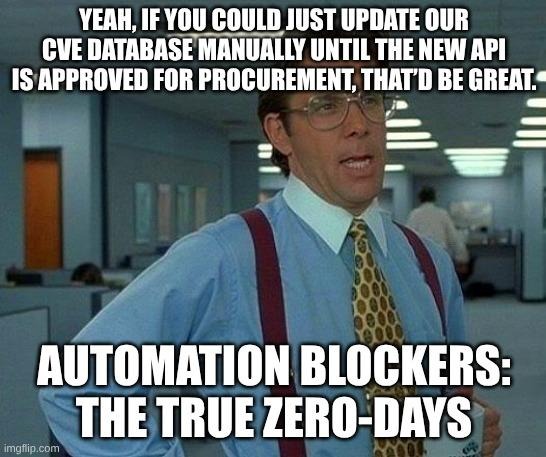
CISA’s Quality Era signals a fundamental shift in how vulnerability data is shared, structured, and consumed. In its strategic roadmap announced on September 10, 2025, CISA outlines plans to modernize the Common Vulnerabilities and Exposures (CVE) ecosystem through expanded API access, richer metadata, and machine-readable formats such as JSON and CVE 5.0. This modernization is not just cosmetic; it redefines the entire lifecycle of vulnerability intelligence by prioritizing timely, automated delivery over static publication. As CISA’s infrastructure evolves, stakeholders will gain access to real-time, contextualized data that is purpose-built for automation-driven environments.
This transformation is poised to benefit a wide array of stakeholders across the security landscape. Security vendors can build tighter integrations into real-time CVE feeds, reducing their time to insight. SOC teams and MSPs can automate prioritization and patch workflows without custom parsers or brittle scraping logic. And CISOs evaluating risk management maturity will find that automation-ready infrastructure enables defensible, metrics-driven decision-making.
This is Part 2 of our CVE Program Vision and Future Outcomes series. Part 1, “The CVE Quality Era: What Security Teams Should Expect from The Next Generation of Vulnerability Data”, introduced the Quality Era and its shift toward richer, more reliable CVE metadata. In this article, we will explore how CISA’s roadmap enables real-time ingestion, AI-powered enrichment, and automation-ready APIs, as well as how these changes transform vulnerability data into a continuously and more directly actionable input for SOAR, SIEM, and patch orchestration workflows.
Why machine-readable, real-time CVE data matters
Historically, CVE data delivery has been hampered by structural limitations. Static XML feeds, delayed update cycles, and insufficient metadata have long hindered enterprise teams’ ability to ingest, correlate, and act on vulnerability information. In contrast, modern API endpoints with expanded query granularity and richer data structures enable streamlined integration with existing security stacks, particularly with Security Orchestration, Automation, and Response (SOAR), Security Information and Event Management (SIEM), Endpoint Detection and Response (EDR), and patch orchestration tools.
The result is not just faster delivery, but smarter consumption and workflow-level automation. Legacy CVE consumption models based on static feeds or manual lookups can introduce dangerous delays into the vulnerability management process. Analysts must often cross-reference records by hand, extract relevant context, and assign priority based on ad hoc judgment. These inefficiencies increase the average window of exposure, especially when teams are overwhelmed or under-resourced. Even modest delays in CVE triage can allow opportunistic attackers to exploit known flaws before remediation is complete.
By contrast, machine-readable CVE data formats like JSON, STIX, and the upcoming CVE 5.0 schema empower automation from the moment a new vulnerability is disclosed. Structured fields such as affected configurations, exploit status, and references enable downstream tools to ingest and correlate findings without manual intervention. This seamless integration accelerates the entire vulnerability lifecycle from ingestion to patch deployment, allowing systems to scale in line with threat velocity. The urgency of real-time data access is reinforced by the pace of KEV catalog updates and NVD enrichment cycles. Increasingly, defenders are expected to detect, contextualize, and mitigate critical exposures within hours, not days. This demand for responsiveness is driving security teams to adopt platforms that support immediate CVE ingestion and automated enrichment.
CISA’s roadmap may also pave the way for future capabilities like:
- SBOM-driven CVE matching: Automated correlation of vulnerabilities to installed packages and libraries.
- Attack path modeling: AI-powered simulations that identify exploitation chains based on exposed assets.
- Asset-centric alerting: Notifications tailored not just to CVE severity but to system relevance and criticality.

The role of AI/ML in vulnerability enrichment
As part of its modernization efforts, CISA and related organizations are investing in AI/ML models that can enhance CVE records with more actionable intelligence. These enhancements include inferred exploitability scores, system-specific impact assessments, and even automatically generated remediation guidance. Such enriched metadata turns raw CVE entries into decision-ready inputs, suitable for automated processing.
AI-enhanced enrichment helps reduce alert fatigue by filtering and ranking vulnerabilities based on contextual relevance. For example, rather than sending every CVE to a queue for manual triage, an AI model can flag the subset most likely to affect an organization’s infrastructure based on past asset inventory, threat intelligence feeds, or historical exposure patterns. This allows security analysts to focus their efforts on the vulnerabilities that matter most.
When paired with modern CVE ingestion methods, these AI models become the basis for intelligent automation. Key use cases include:
- Asset-aware risk prioritization: Models can correlate CVEs with real-time asset data to identify true risk exposure.
- Exploit likelihood estimation: AI classifiers trained on threat intel sources can flag CVEs with active exploitation in the wild.
- Dynamic patch sequencing: Machine learning can help schedule patch deployment based on operational risk, SLA targets, and business criticality.

A walkthrough of modern CVE ingestion and response
Consider a fictional enterprise, let’s call it ExampleCo, that uses an automation-driven vulnerability management platform such as vRx by Vicarius. Each day, ExampleCo’s systems poll the CISA APIs for newly published or updated CVEs. These CVEs are ingested via JSON-formatted endpoints and immediately parsed by the platform’s enrichment engine, which overlays them with asset data, exploitability scores, and known KEV tags.
The CVE pipeline then follows a structured automation path:
- Ingestion: Real-time polling pulls updated CVE entries from CISA’s API.
- Parsing: Data is normalized into structured records and cross-referenced with ExampleCo’s asset inventory.
- Enrichment: External feeds and internal intelligence sources add exploit indicators, KEV flags, and business context.
- Exposure mapping: Affected systems are automatically flagged based on asset-CVE correlation.
- Prioritization: Scoring algorithms and custom policies rank vulnerabilities by urgency and exposure level.
- Patch deployment: Integrations with ExampleCo’s patch management tooling initiate remediation workflows.
By replacing manual review and ticket creation with automated mapping and orchestration, ExampleCo improves both response speed and consistency. Operational goals such as mean time to remediation (MTTR), SLA compliance, and KEV response rates become achievable metrics, not aspirational targets.
Strategic advantages for platforms with automation-ready design
Security platforms designed to support modular ingestion stand to gain a decisive edge, especially those compatible with CVE 5.0 and CISA’s evolving API structure. These platforms can ingest vulnerability data in real time, update internal risk models dynamically, and pass structured outputs to SOAR or ticketing systems without breaking the chain of automation. vRx, for instance, pairs an ingestion-ready architecture with internal enrichment capabilities and customizable prioritization logic. This allows teams to define policies that reflect real-world risk tolerance, whether that means reacting instantly to KEV entries or de-prioritizing CVEs in sandboxed segments. More importantly, it enables security teams to scale response capacity without increasing headcount.
Key operational benefits of automation-native platforms include:
- Resilience during high-volume threat events: Systems continue processing even as CVE volume surges.
- Adaptability to evolving data schemas: Native support for machine-readable formats ensures smooth transitions.
- Empowerment of lean teams: AI-assisted triage compresses hours of work into minutes, leveling the playing field for small SOCs.

Redefining readiness: CVE automation as operational advantage
The shift toward API-first CVE infrastructure represents more than a technical update. It transforms vulnerability management into an engine for continuous risk reduction. Instead of reacting to point-in-time findings, teams can now ingest enriched CVE streams, correlate them with live asset telemetry, and launch targeted remediation automatically. This is the foundation of exposure management maturity.
Organizations should assess their current vulnerability tooling to determine whether it can ingest, enrich, and operationalize CVE data in the formats that CISA will soon standardize. Those stuck on legacy platforms or point-product patch tools will likely struggle to adapt without a major overhaul.
For a more detailed look at the foundational changes to CVE metadata and the broader Quality Era shift, see part 1 of this series, “The CVE Quality Era: What Security Teams Should Expect from The Next Generation of Vulnerability Data”. In Part 3, Global trust, local action: Aligning enterprise vulnerability disclosure with CISA’s transparency vision, we’ll explore practical strategies for aligning internal processes with CISA’s roadmap and what security leaders can do now to prepare for evolving requirements. To see how vRx can help your team automate CVE ingestion and response across your full attack surface, request a demo today!












